Site menu:
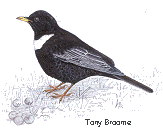
May 2019 Newsletter
Ring Ouzels in Spring.
Colour Ring Report.
April Bird News.
Forthcoming Events.
Latest Newsletter.
Ring Ouzels in Spring
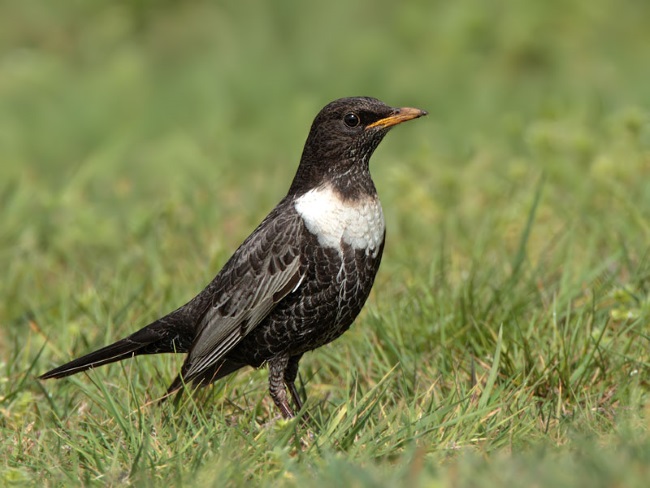
2019 has seen the best spring passage of Ring Ouzels for the past 15
years. Not only have we had the highest spring total over that
time, 43, but also the highest single site count with at least 10 at
Leasowe on April 18th including a flock of seven.
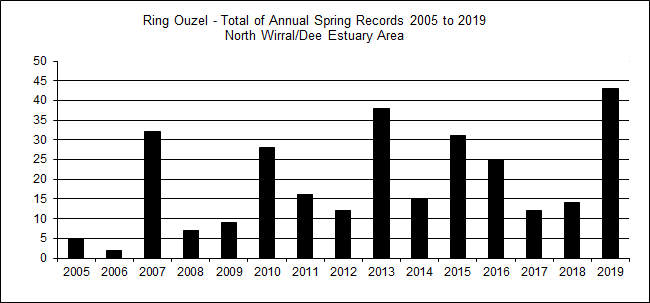
The bar chart above shows the sum of daily spring records for each year - 2005 to 2019. As you can see there appears to be a cycle peaking every three years with only 2015 spoiling the picture. To my mind the pattern doesn't make any sense! As we see only a tiny proportion of the birds which are flying through the country, or indeed up the west coast, you would have thought numbers here should be governed solely by weather events such as wind strength and direction, cloud cover, amount of early morning mist etc. and therefore would be purely random and not show a pattern. Steve Stansfield kindly sent the Ring Ouzel spring records from Bardsey Bird Observatory (2006 to 2017) and these show no discernible pattern, and, in contrast to the Dee, 2019 has been a poor year for them with just six records up to April 26th, compared to 45 in 2015 but only five in 2013 when we had 38 - i.e no correlation whatsoever between the Dee and Bardsey. So it remains an intriguing mystery. I would have liked to have gone further back but unfortunately my records are incomplete prior to 2005.
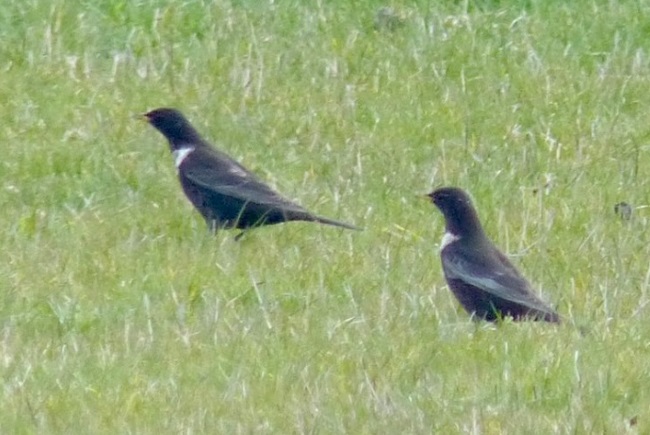
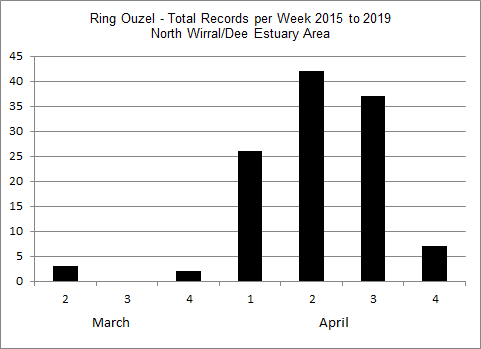
Nearly all our Ring Ouzels come through in April with just a handful in March. The early ones are likely to be British breeding birds whereas the large majority of those in April will be on their way to Scandinavia. In any particular year most birds pass through in just a few days but the timing of this peak can differ - so in 2015 25 birds were recorded in the second week of April, in 2016 we had 17 in the first week and in 2019 25 in the third week.
I finish the article with some thoughts from local birder Eddie Williams who has been following the migration of Ring Ouzels both here and in North Wales for a good number of years:
I do have a few thoughts on the migration of Ouzels through our region based on my own observations.
The nearest main traditional spring stopping off points for migrant Ouzels (vast majority being Scandinavian birds) are along the Clwyd Hills just across the Dee from us. They run as a south-north axis along their route and contain prime Ouzel habitat, although they no longer breed here. I get up there about once a week during spring migration and in about 70% of visits connect with Ouzels, usually in small groups of between 3 and 8 birds, although double figure flocks are by no means uncommon. As an indication of the large numbers passing through; On the 8th April last year their were separate flocks of 16, 6 and 9 on Penycloddiau with another group of 5 on neighbouring Moel y Parc, 36 in a morning! The whole area is hardly covered by birders so the numbers going through unnoticed must be huge. Birds only seem to stick around for a day or so before moving on, similar to the Wirral coast.
Most records of Ouzels on the Wirral seem to consist of single birds in contrast to the Clwyd Hills where records of singles are in the minority. It seems to me that a few birds choose to follow the coast rather than the traditional route, with others becoming slightly displaced. Displacement I think is the reason for many of the records we have seen on Wirral this spring. On 18th April in particular 10 birds were at Leasowe, inc flock of 7, and another group of 3 on Red Rocks with singles on Hilbre, Ness and Caldy. The weather conditions that morning were slightly misty. This mist would have also obscured the Clwyd Hills for any Ouzels either heading north or intending to stop there, forcing them to re-orientate along the nearby coast, with some stopping off. Hence the numbers I would usually associate with the Clwyd Hills being present on the Wirral coast on that day.
By the way the situation is completely different in autumn when Scandinavian Ouzels follow a far more easterly route south and are extremely rare on the Clwyd Hills then. Birds seen then on Wirral are more likely traditional 'easterly drift' migrants.
Eddie Williams
Eddie makes the point that the vast majority of Ring Ouzels seen both
along north Wirral and the Clwyd Range are Scandinavian breeders. I
asked him if we knew that for sure and why couldn't some be Scottish
breeding birds. He replied:
1. I have noted numbers and dates through the Clwyds for last 11 years visiting regularly once a week during spring passage. The volume of passage has been heavy and constant, showing no reduction in numbers which would be reflected if these were Scottish breeders due to recent big declines there. This decline is not reflected in Scandinavian populations, which remain healthy.
2. The actual number of birds involved in the passage indicates destinations other than within UK as our native population is relatively small. There is also recognised evidence that Ouzels take a more westerly route in spring, this including Scandinavian birds.
3. The timing of the sightings are relevant. Most British Ouzels arrive on breeding grounds late March to early April but I am getting large groups still passing through in last week of April into early May. e.g. 9 on 28.4.08, 6 on 28.4.13 and 5 on 6th May, these groups still contain good proportions of males which would usually be first to arrive on territory. Weekly totals are fairly constant throughout April. Scandinavian breeders arrive later on their breeding ground due to later snow melt.
While there are likely some Scottish birds involved in the passage, especially some recorded late March to early April, I believe the majority are Scandinavia bound. I am hoping for a colour ringed bird one day.
Eddie Williams
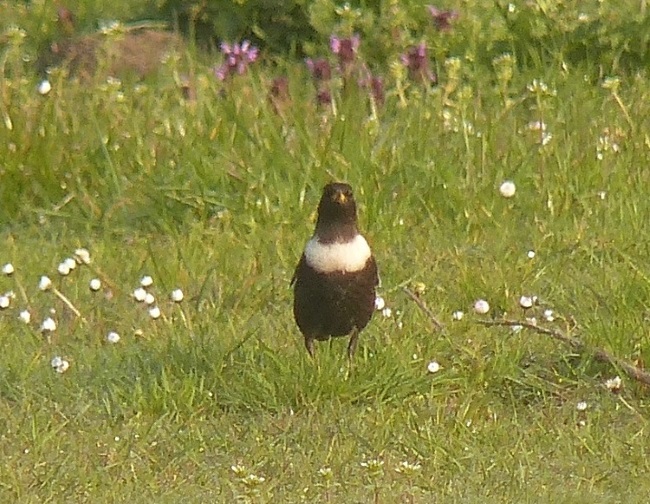
Ring Ouzel Status
British breeding birds are declining such that they have at least halved in number over the past 30 to 40 years and probably currently down to 5,000 to 6,000 pairs. As Eddie has already mentioned numbers in Scandinavia seem to be stable although exactly how many there are is not really known, one source said the number of pairs in Norway was anywhere between 10,000 and 100,000 pairs! Even in the UK, where there have been regular surveys, their habitat of rocky mountain crags and steep slopes means accurate counting is very difficult and you can certainly imagine the problems of trying to estimate numbers in the mountains of Norway even if you could get the volunteers to do it.
Ring Ouzels used to breed in the Clwyd Hills, probably up to the 1980s, but there could still be one or two pairs in the eastern hills of Cheshire, down from the four pairs estimated during the Cheshire and Wirral Bird Atlas surveys (2004 to 2007), and a few more pairs are said to breed in Derbyshire just across the border. According to reports several years ago Ring Ouzels are doing well in Snowdonia with around 160 territories. Why British breeding birds are declining is not fully understood but climate change, change of land use and French hunters during migration are all likely contributors.
Latest News... I hear that 2019 seems to have been a good breeding season in Yorkshire where in one 15 mile valley out of nine pairs two nests fledged six young per pair, whilst at Capel Curig in Snowdonia two nests each fledged four young (info from Paul Sothern). Hopefully the good weather for most of April means it has been a good breeding season elsewhere.
References and Further Reeding
1. Latest sightings from 2005 to 2019 on http://www.deeestuary.co.uk/, thanks to all those who contributed.2. Allan Conlin, Eddie Williams and Steve Williams (pers.comm. April 2019).
3. Ring Ouzel Study Group http://www.ringouzel.info/index.html. This website has much useful information and links to other sites.
4. European Red List of Birds published by BirdLife International, Turdus torquatus (Ring Ouzel), supplementary Material, 2015.
Richard Smith
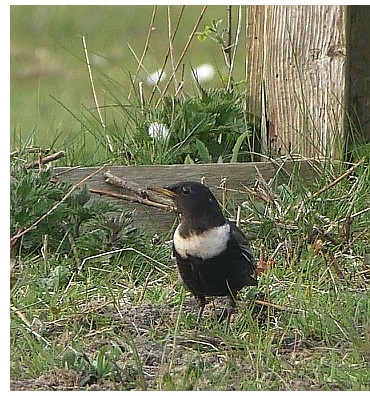
Top of Page
Colour Ring Report
Mediterranean Gull
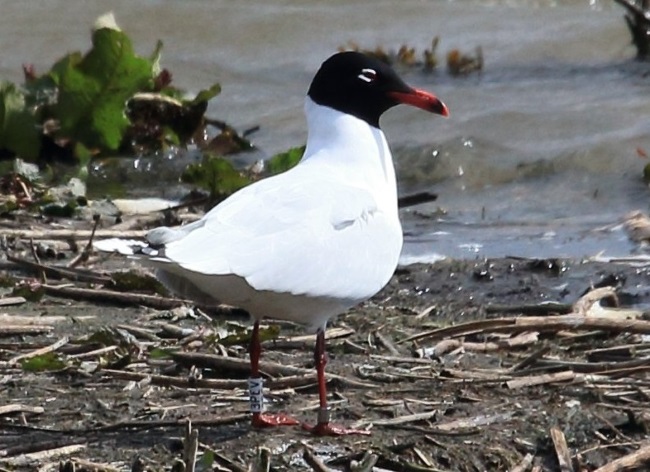
© Carole Killikelly
3PEV on white ring.
Ringed on De Krepel island, Ijsselmeer, northern Netherlands, on June
19th 2017.
Recorded at:
Easington, Yorkshire, on September 27th 2017.
Slimbridge WWT, Gloucestershire, on April 4th 2018.
Titchwell RSPB, Norfolk, on April 20th and May 2nd 2018.
Griend island (Waddensee), northern Netherlands, on May 28th 2018.
Burton Mere Wetlands RSPB, Dee estuary, on April 13th 2019.
De Krepel is a small artificial island and nature reserve in the
Ijsselmeer.
This bird was certainly doing a lot of flying last spring being seen
at the famous bird reserves of Slimbridge (on the west coast) and
Titchwell (on the east coast) before flying to the lonely island of
Griend on the Waddensee where many knot are colour ringed by the Dutch
and seen here on the Dee estuary.
Avocet
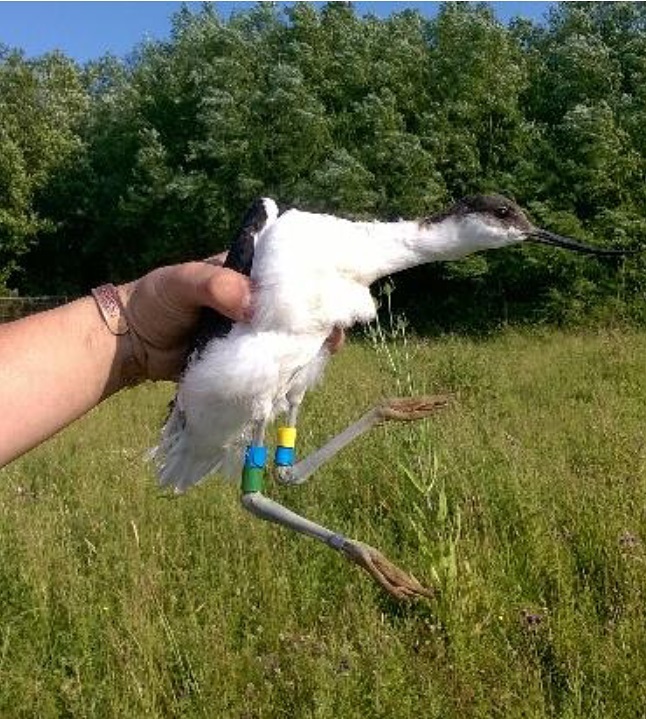
YB-BG - Ringed at Rutland
Water NR on July 15th 2015 as a chick, one of a brood of three.
Recorded at Summer Leys LNR, Northamptonshire, on March 24th 2017.
Recorded at Burton Mere Wetlands RSPB on April 17th and May 3rd 2018,
and on April 1st 2019.
Oystercatcher
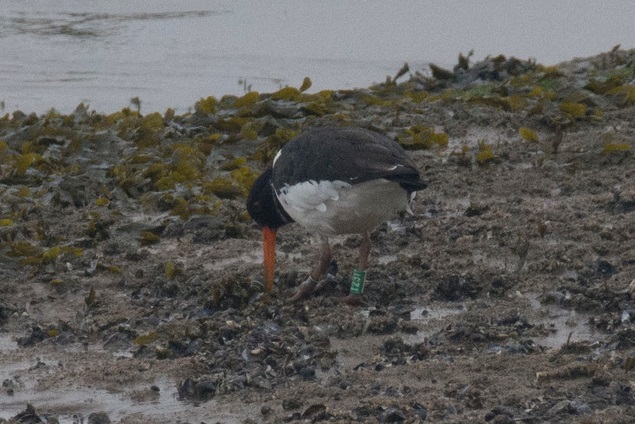
T231 - on green ring.
Ringed on Meland Island (just north of Bergen), Norway, on July 19th,
2017.
Recorded at the ringing site in August 2017.
Recorded on Hilbre on April 16th 2019.
I expect we get plenty of Oystercatchers here which
breed in Norway but this is the first colour-ringed bird from there
we've seen.
Black-tailed Godwit
RO-LH Red over Orange left leg, Light green over light green ring enscribed with letter 'H'.Ringed on the Tagus estuary, Portugal, on January 7th 2019.
Recorded at Burton Mere Wetlands RSPB on April 4th 2019.
It was August 2013 since we last saw a Portugese ringed Black-tailed Godwit (ringed by Jose Alves) although we have seen a few ringed in Spain during that period.
Curlew
FAC - Left Tibia: white ring with black lettering FAC reading upwards. Left tarsus: metal.Ringed at Haapavesi, Kyokyla, Finland, on July 6th 2017, as a juvenile.
Recorded on Heswall Shore in June and July 2018.
Recorded on Heswall Shore on April 17th and 29th 2019.
As a one year old this bird over-summered on the Dee Estuary in 2018, in 2019 we would expect it to return to Finland to breed.
Shelduck
In March we had our first colour-ringed Shelduck - L3 on a lime green
ring. That bird has since been recorded a further six times in March and
April on Heswall shore, and has now been joined by a second one.IT on lime green ring, left tarsus.
Ringed at Martin Mere WWT on November 19th 2018.
Recorded at Martin Mere WWT in February and March 2019, last seen ther eon March 8th.
Recorded on Thurstaston Shore on April 13th 2019.
Colour-ringed birds were recorded by Steve Hinde, Phil Woollen (Hilbre
Bird Observatory), Dave Winnard, Colin Schofield, Carole Killikelly
and Richard Smith.
April Bird News
Wow! What a month for Yellow Wagtails. As some may be confused with talk of Channel Wagtails, Blue-headed Wagtails, Spanish Wagtails, flava and flavissima there is an excellent article on BirdGuides called 'Focus on: shades of Yellow Wagtail' which explains it all. Click here for this Yellow Wagtail Article. Hopefully the photos below will also help.
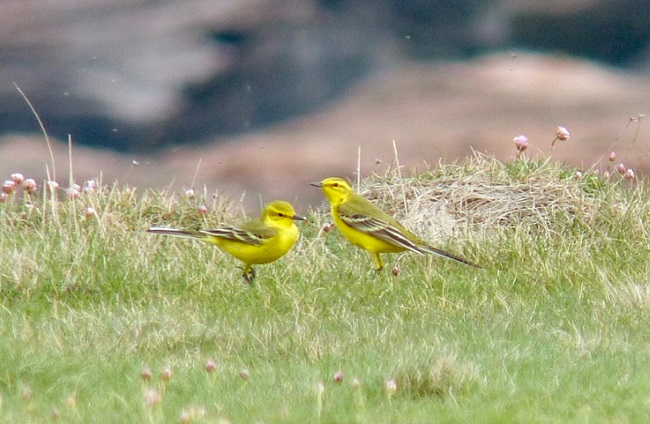
Motacilla flava flavissima - regular summer visitors to the UK
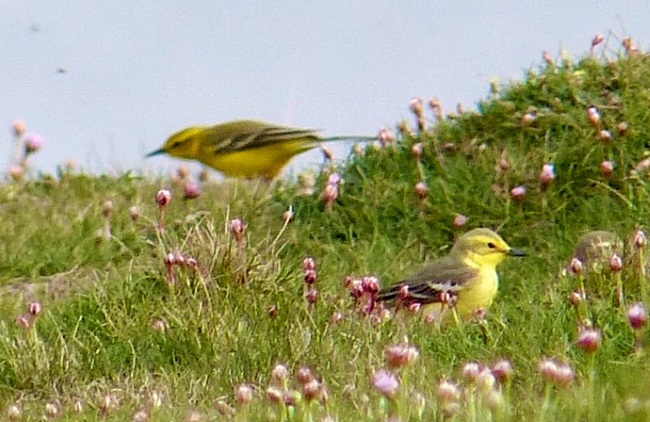
This could be a natural variation in Yellow Wagtail plumage or perhaps a hybrid of some sort.
Photographed by Steve Williams on Hilbre on April 23rd.
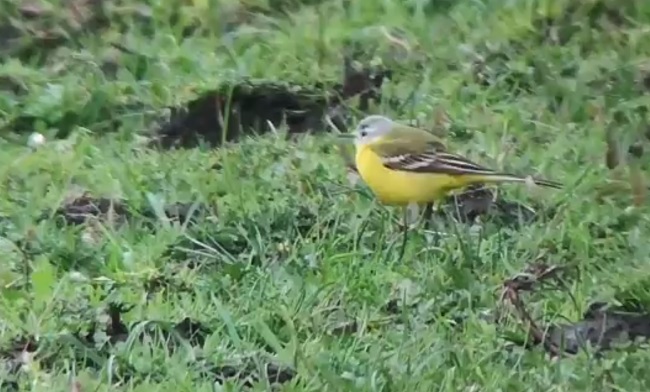
In northern France there is an area where Yellow Wagtails and Blue-headed Wagtails ( Motacilla flava flava) regularly interbreed producing the so-called 'Channel Wagtail'.
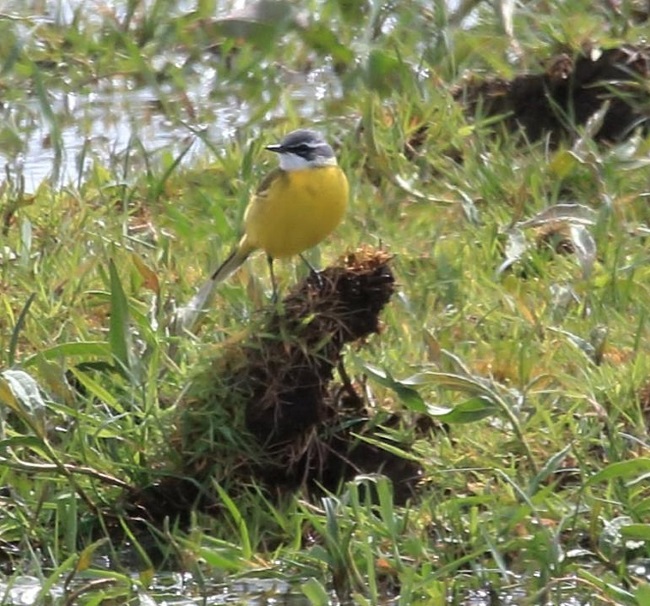
April 28th © Carole Killikelly
It's been a great year for Yellow Wagtails with a max count of at least 40 at Leasowe Lighthouse on the 22nd. Hilbre rarely gets more than ones and twos as most fly over, so it was fantastic to have 23 on the island on the 21st and 31 two days later. Channel Wagtails (Yellow/Blue-headed Wagtail intergrade - M f flava x favissima) are unusual here, and we rarely get more than the odd one, so to get seven records was great. Two turned up at Burton Mere Wetlands on the 14th and later in the month we had a few at Leasowe Lighthouse. But the sumptuous icing on the cake was the arrival of a Spanish Wagtail (Motacilla flava iberiae) found by Stan Davidson in Kerr's Field at Leasowe on the 26th, despite gales and rain on the 27th it was still present on the 28th and briefly the next day. Although it will be a while before we know if it has been accepted all the indications are is that it will be, only the second for the UK and thus becomes Wirral's rarest ever bird!
| Species | 2019 | Location | 2018 | 2017 |
|---|---|---|---|---|
| Sand Martin | 16th Feb | New Brighton | 15th March | 11th March |
| Wheatear | 27th Feb | Hoylake | 9th March | 11th March |
| White Wagtail | 28th Feb | Leasowe Lighthouse |
14th March | 4th March |
| Swallow | 21st March | Leasowe Lighthouse |
29th March | 14th March |
| Willow Warbler | 24th March | Hoylake | 27th March | 17th March |
| House Martin | 31st March | Leasowe Lighthouse |
6th April | 27th March |
| Whitethroat | 14th April |
Leasowe Lighthouse |
7th April | 17th April |
| Cuckoo | 18th April | Heswall | 23rd April | 24th April |
| Swift | 23rd April |
Ledsham | 22nd April | 19th April |
The spring migration was more or less on schedule as you can see from the table, that is except for summer weather in February.
Apart from the Ring Ouzels as described in the above article, and a good number of Common Redstarts and Wheatears (100+ on the 19th) the most remarkable birds were the 17 Mediterranean Gulls which turned up at Burton Mere Wetlands, easily a record count for the Dee estuary area. I'm not sure how many are actually breeding but the first successful breeding took place only in 2017 and that was just one pair.
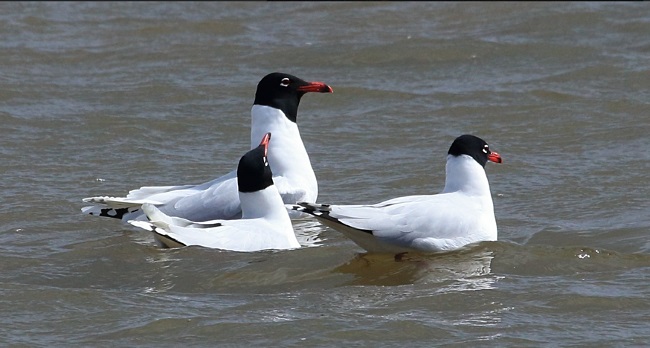
The first Sandwich Terns arrived on the 2nd, the first Common Terns on the 14th and Little Terns on the 18th. There was some good seawatching towards the end of the month including over 300 Gannets and 600 Sandwich Terns seen from Hilbre.
Highest counts of Whimbrels was 79 at Heswall on the 24th, more unusually has been a small flock feeding in the horse paddocks at Leasowe. Otherwise the estuary has been fairly quiet with regards waders.A Black Tern at Burton Mere Wetlands and five Crossbills at Thurstaston rounded the month off nicely.
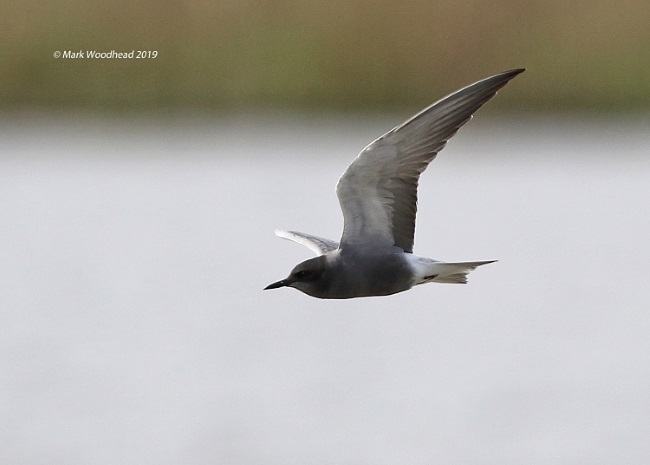
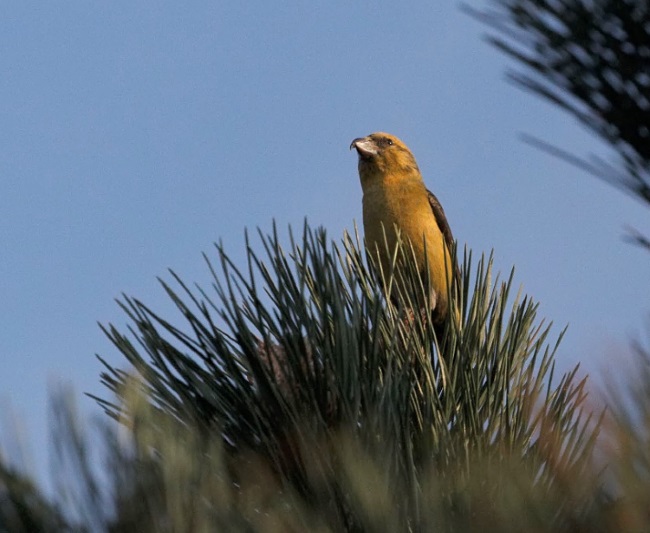
Top of Page
What to expect in May
Any fresh westerlies should see good numbers of Gannets, Manx Shearwaters, terns and skuas.
May is a particularly good month for rarities and just the past two years has brought in Iberian Chiffchaffs, Ring-necked Duck, Gull-billed Tern, Spotted Crake, Sub-alpine Warbler, Shorelark, Hoopoe, Buff-breasted Sandpiper, Turtle Dove and Roseate Tern.
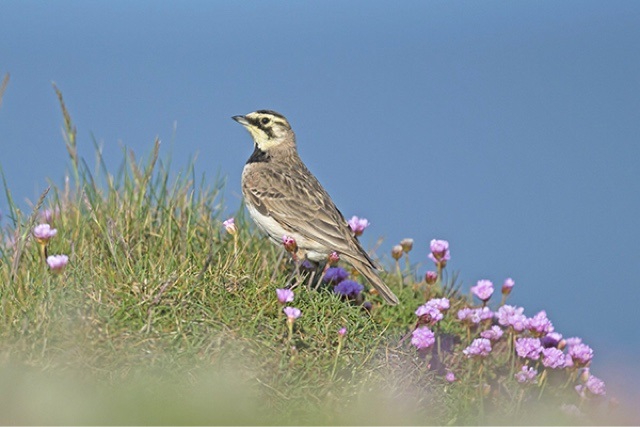
Forthcoming Events
May Highest Spring Tides (Liverpool)
Also see Tides page.
18th May, 11.32hrs (BST), 9.4m.
19th May, 12.15hrs (BST), 9.5m.
Forthcoming Events
Organised by the Wirral Ranger Service , Flintshire Countryside Service and the RSPB (Dee Estuary): All these events and walks have bird interest, even those not advertised specifically for birdwatching. No need to book for these events unless specified - please check below.
Gronant Little Tern Colony Tasks
To find out more about the Gronant Little Tern colony click here, see the Little Tern Facebook page or the North Wales Little Tern Group Website - https://northwaleslittleterns.weebly.com/.Monday 29th April to Thursday 2nd May.
Gronant Little Tern Colony. There is over a kilometre of electric fencing to construct to protect one of the largest Little Tern colonies in Britain and Ireland. Meet at the new 'shelter' at the end of the old boardwalk 10:00 am, next to the beach. There is a car park opposite the Crofter’s Cafe on Shore Road, Gronant
VOLUNTEERS NEEDED!
For further details ring 01352 810614 or 01745 356197
Sunday 5th May, Dawn Chorus at Burton Mere Wetlands.
5-7am
Price: £15 per person / £12 RSPB members (plus Eventbrite booking fees)
Booking essential
In celebration of the RSPB Dee Estuary reserve's 40th anniversary, and to mark International Dawn Chorus Day, join us on a guided walk around Burton Mere Wetlands to experience the magic of the reserve waking up as the sun rises. With a wonderful mixture of woodland and wetlands, there's no better place to experience the early morning birdsong.
An expert guide will help identify the bird calls and songs around you, plus all the other kinds of wildlife that makes its home here. Enjoy a hot drink afterwards in the vistor centre, then a chance to explore the rest of the reserve on your own before it opens at 9am.
Wear sturdy footwear and warm, layered clothing appropriate for the weather on the day, and bringing a waterproof layer is always wise. Don't forget your binoculars if you have some, otherwise you can hire from us on the day.
Advanced booking and payment essential, via Eventbrite: https://deedawnchorus.eventbrite.co.uk
Telephone 0151 353 2720 for further information.
Saturday 11th May, Burton Marsh Birdsong and Breakfast.
7-10am
Price: £15 per person / £12 RSPB members (plus Eventbrite booking fees)
Booking essential
In celebration of the RSPB Dee Estuary reserve's 40th anniversary, join us for this 'not-quite-dawn chorus' with a difference; a gentle walk along the Burton Marsh Greenway as far as Burton Point before retracing our steps to Denhall Lane as far as Nets Cafe for a full English breakfast.
A variety of warblers are busy establishing breeding territories here at this time of year, whilst the marsh is peppered with other summer migrants such as wheatears and alive with the songs of skylarks and meadow pipits. This early morning walk will offer chance to see and hear the marsh coming to life for the day in this busy time for nesting and migrating birds.
Price includes breakfast at Nets Cafe. The route is along a fully accessible paved track. Toilets available at end of walk.
Advanced booking and payment essential, via Eventbrite:
https://birdsong-and-breakfast.eventbrite.co.uk
Directions:
Meet at the junction of Station Road and Denhall Lane, west of Burton village. Nearest postcode CH64 0TG.
Telephone 0151 353 2720 for further information.